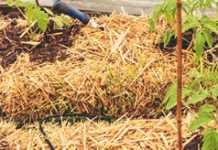https://hnr.k-state.edu/extension/info-center/newsletters/index.html
Blog Post: http://www.ksuhortnewsletter.org
Video of the Week: Choosing the Best Poinsettia
https://kansashealthyyards.org/all-videos/video/choosing-the-best-poinsettia
UPCOMING EVENTS
Kansas Turf & Landscape Conference
The 73rd Annual Kansas Turf & Landscape Conference will be held on Wednesday, November 29 and Thursday, November 30 at the Hilton Garden Inn, Manhattan. The conference is an excellent way to learn about turf and landscape management, visit with old friends, network with new ones, and see all the latest products and supplies from local and national vendors.
The conference has been approved for commercial pesticide recertification hours:
1 Core hour
3A – 7 hours
3B – 7hours
GCSAA education points and International Society of Arboriculture CEUS will also be available by attending the conference.
For more information, go to https://www.kansasturfgrassfoundation.com/
REMINDERS
- Take a soil test and make needed adjustments this fall.
- Till fallen tree leaves into garden beds
FRUIT
Winterizing Strawberry Plants
Preparing strawberries for winter requires adding a layer of mulch over the plants at the proper timing. Adding mulch too soon prevents the plants from acclimatizing to the cold weather and makes them less hardy to temperature extremes.
Mulch helps regulate soil temperature and prevents repeated freezing and thawing which can heave plants right out of the ground. This can be damaging to the plants and can result in death. By this point in the year, we have already had several days of low temperatures, and it is likely safe to go ahead and mulch strawberry plants.
Straw is the best option for mulch in this case. Apply three to five inches of straw over the plants using a wire or plastic fencing to hold the straw in place if necessary. Strawberries grown in raised beds need a few extra inches of mulch since they are not as well-insulated. Container-grown strawberries will not likely survive our winter if left outdoors. Consider bringing the container into a garage or shed for protection through winter.
In the spring as new growth appears, remove the straw a little bit at a time to re-introduce the plants to the elements. Make sure the temperature is above 32 degrees F to avoid damaging new buds. A light layer of mulch can be left in place to keep the berries off the ground and to help retain moisture in the soil. (Cynthia Domenghini)
FLOWERS
Poinsettia Care
Though commonly grown for the winter holiday season, poinsettias can be maintained year-round. The attractive greenery and colorful bracts make a great addition to the home. The botanical flowers of poinsettias are the yellow parts in the center of what most think of as the bloom. Bracts are the colorful parts ranging from red, white, green, pink and combinations of these colors. Bracts are technically leaves and some florists and nurseries will spray paint them to offer other less traditional colors such as blue.
Poinsettias do best with temperatures between 65- and 75-degrees F. Consistency is key so avoid drafts from windows, or heat sources such as the fireplace or space heaters. Bright, indirect light is preferred but keep the leaves from touching cold windows.
Soil should be kept moist. If it dries completely, the poinsettia will wilt and potentially lose some leaves. Water the plant in the sink until water runs through the drainage holes of the container. If the poinsettia is left in standing water such as in a saucer or in the plastic sleeve they are often sold in, the roots will rot.
Fertilizing and other maintenance is not necessary until after the holidays. (Cynthia Domenghini)
Are Poinsettias Poisonous?
Since childhood I’ve heard that poinsettias are poisonous and should not be kept in a home that has pets indoors. The origins of this rumor are not certain though the effects are widespread. Studies have been done on humans and animals to report side effects of consuming poinsettias. Though some negative gastrointestinal symptoms may occur if large quantities of a poinsettia us consumed, the plants are not considered a major health risk to animals or humans. Regardless, poinsettias are not considered edible and families with pets that are prone to chewing should keep indoor plants out of reach.
As a member of the Euphorbiaceae family, poinsettias are related to the rubber tree. The rubber tree is responsible for the production of natural latex. For this reason, anyone with a latex intolerance may be sensitive to direct contact with poinsettias as well. (Cynthia Domenghini)
MISCELLANEOUS
USDA Plant Hardiness Zone Map Update
The USDA plant hardiness zone map is a resource many gardeners use to aide in decisions regarding plant selections. The map represents the average annual extreme minimum temperature for a certain location and a particular time period. This information has been gathered over 30 years from thousands of weather stations. A new USDA map has just been released as an update from the 2012 map.
The 2023 map is intended to be more user-friendly and designed for the Internet. Better data and technology have enabled the map to account for microclimates within regions where the zones may slightly vary from a rural area to more developed cities and towns as well as areas of elevation change.
With the new guidelines, most of Kansas is now within zones 6a to 7a. For many of us the new zoning represents a change of half a hardiness zone. This could mean more options for growing during cool seasons.
To access the updated 2023 USDA Plant Hardiness Zone Map and find resources to use the map for your location you can visit this site: https://planthardiness.ars.usda.gov/. (Cynthia Domenghini)
Ashes in the Garden
Before adding supplements to the garden, it is helpful to know the soil conditions. Soil tests can be done with help from your local extension unit. Ashes are a significant source of potash but provide a very small amount of phosphate and no nitrogen. There are many sources that recommend using ashes as a fertilizer, but soils vary from one region to another. Since most Kansas soils have naturally high rates of potash, incorporating ashes to the soil is not beneficial. In fact, this could be problematic since wood ashes will raise the pH of the soil and our soil tends to have a high pH naturally. Finding alternative ways to dispose of ashes is a better option for our area. (Cynthia Domenghini)
Storing Power Equipment for the Winter
This is a good time to service power equipment such as mowers, tillers and garden tractors. Run the equipment out of gas or treat the existing gas with a stabilizer as untreated gas can deteriorate over time. If using a stabilizer, run the engine long enough for untreated gas in the carburetor bowl to be burned and replaced. This is also a good time to replace the oil (and filter, if present) since the engine is warm. Check and replace the spark plug if necessary. Some gardeners will also apply a light, sprayable oil into the cylinder through the spark plug hole. Check and clean air filters and replace if necessary. Many mowers and tillers will have a foam prefilter that can become filthy with use. If allowed to become too dirty, engines will run poorly or may not run at all.
Sharpen blades, clean tines, tighten screws and replace broken parts. Doing this maintenance now will help reduce frustration and lost time due to poorly performing equipment next spring. (Ward Upham)
Why Do Houseplants Lose Leaves After Being Brought Inside?
Houseplants drop their leaves in response to several conditions: too much or too little water, restricted root growth, temperature is too cold or a rapid change in the growing environment. Many gardeners move their houseplants outdoors for the summer season. With the recent move back indoors, and the change in light, these plants may experience leaf drop. The good news is the plants should self-correct within a few weeks if they receive adequate care.
Remember, growth will typically slow down significantly as plants respond to the change in environment. Water only as needed and avoid the temptation to fertilize your plants at this time. Allow time for plants to acclimate to their new location. When plants are brought indoors or even when they are brought home from the store, the light conditions will be different. Try to expose plants to this change gradually. If plants were receiving bright light in their previous location position them near the window that receives the brightest light in your home. If their permanent location is darker, take time to move the plants allowing them to adjust to less and less light. It can take four to eight weeks for plants to acclimate depending on how drastic the light difference is. When the weather warms up follow the same process in reverse as you prepare to re-introduce the plants to the outdoors. (Cynthia Domenghini)
Contributors:
Cynthia Domenghini, Instructor & Horticulture Extension Specialist
Ward Upham, Extension Associate
Department of Horticulture and Natural Resources
1712 Claflin, 2021 Throckmorton
Manhattan, KS 66506
(785) 532-6173
For questions or further information, contact: [email protected], [[email protected]%20][email protected] OR [[email protected]][email protected]
This newsletter is also available on the World Wide Web at:
http://hnr.k-state.edu/extension/info-center/newsletters/index.html
The web version includes color images that illustrate subjects discussed. To subscribe to this newsletter electronically, send an e-mail message to [email protected], [[email protected]][email protected] or [[email protected]%20][email protected] listing your e-mail address in the message.
Brand names appearing in this newsletter are for product identification purposes only. No endorsement is intended, nor is criticism implied of similar products not mentioned.
K-State Research and Extension is committed to making its services, activities and programs accessible to all participants. If you have special requirements due to a physical, vision or hearing disability, or a dietary restriction please contact Extension Horticulture at (785) 532-6173.
Kansas State University Agricultural Experiment Station and Cooperative Extension Service K-State Research and Extension is an equal opportunity employer. Issued in furtherance of Cooperative Extension Work, Acts of May 8 and June 30, 1914, as amended. Kansas State University, County Extension Councils, and United States Department of Agriculture Cooperating, Ernie Minton, Dean.




